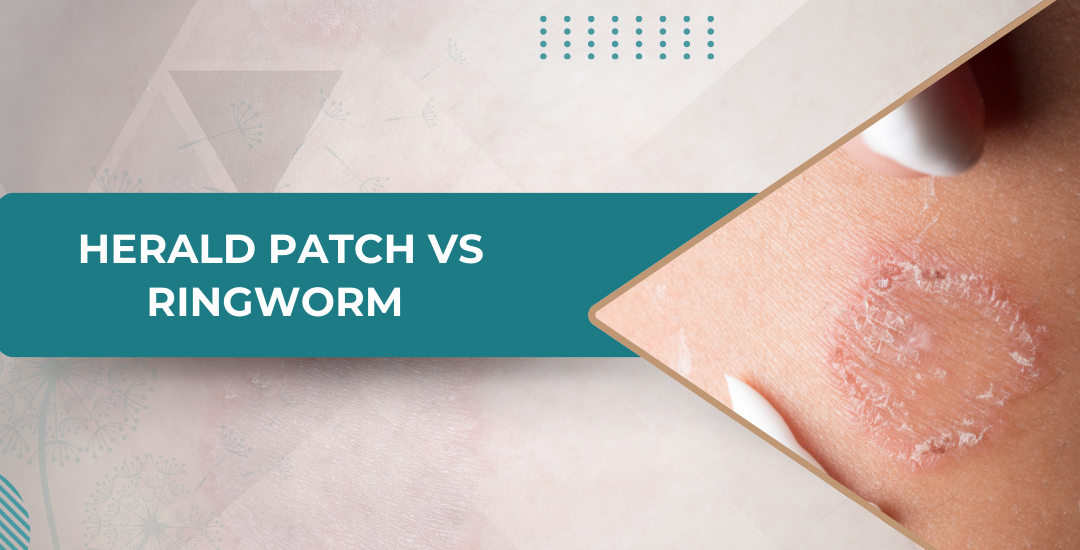Ever noticed an unusual rash on your skin and wondered if it’s serious? Skin conditions like herald patch (pityriasis rosea) and ringworm (tinea corporis) often look similar at first glance, making it tricky to tell them apart. But don’t worry—while they may appear alike, their causes, symptoms, and treatments are quite different.
According to Dr. Swetha, a leading dermatologist in Indiranagar, Bangalore, with over a decade of experience treating diverse skin conditions,
“Recognizing the subtle differences early on is crucial to managing skin problems effectively.”
In this blog, we will break down herald patch vs. ringworm, helping you understand their distinctions so you can identify and address them with confidence.
Now, let’s dive deeper into these two skin conditions: Pityriasis Rosea vs. Tinea Corporis.
What is Herald Patch (Pityriasis Rosea)?

Herald patch, also referred to as pityriasis rosea, is a temporary skin condition often triggered by a viral infection. It usually affects individuals between the ages of 10 and 35. While the exact cause remains unclear, it is believed to be linked to reactivation of certain herpes viruses (not the type responsible for cold sores or genital herpes).
Symptoms of Herald Patch
Initial Patch: The condition starts with a single, oval-shaped lesion called the “herald patch,” which is usually pink or red and slightly scaly
Spread:Within a few days to weeks, smaller patches appear, often forming a Christmas-tree pattern on the back.
Location:Commonly affects the torso, neck, and upper arms.
Duration:Symptoms usually resolve within 6 to 8 weeks without treatment.
Concerned about a skin condition? Consult a dermatologist for an accurate diagnosis and care options.
What is Ringworm (Tinea Corporis)?

Ringworm, or tinea corporis, is a highly contagious fungal infection caused by dermatophytes. Unlike its name suggests, ringworm isn’t caused by worms but by fungi that thrive in warm, moist environments. It can spread through direct contact with infected people, animals, or contaminated surfaces.
Symptoms of Ringworm
Ring-Shaped Rash:The hallmark of ringworm is a circular, scaly rash with a clear center and a raised, red border.
Itching:The affected areas are often itchy and may become inflamed.
Location:Commonly appears on the arms, legs, trunk, or face, though it can affect any part of the body.
Contagion:The condition spreads easily and may require antifungal treatment for resolution.
Noticed a suspicious rash? Connect with a skin specialist to uncover the cause and explore the best treatment options.
Curious about how pityriasis rosea vs. ringworm compare? Let’s break it down.
Key Differences Between Herald Patch and Ringworm

Appearance
- Herald Patch:Starts with one large lesion, followed by smaller, less distinct patches.
- Ringworm:Features distinct, circular, ring-like rashes with raised borders.
Location
- Herald Patch:Primarily affects the torso, neck, and upper arms.
- Ringworm:Can appear anywhere on the body but often affects exposed skin.
Itchiness
- Herald Patch:Itching may occur, but it is usually mild or absent.
- Ringworm:Commonly causes significant itching.
Treatment
- Herald Patch:Generally, resolves on its own without treatment. Over-the-counter antihistamines or topical steroids can help manage mild itching.
- Ringworm:Requires antifungal creams or oral medications for effective treatment.
Struggling to identify your rash? Get a clear diagnosis and effective treatment plan from a dermatologist. Book your appointment today.
Now, let’s discuss when it’s necessary to seek medical attention.
When to See a Doctor

If you are unsure about the nature of your skin condition or if symptoms worsen, consult a healthcare provider. Seek medical advice if:
- The rash spreads quickly.
- Over-the-counter treatments are ineffective.
- You experience severe itching or pain.
As Dr. Swetha, a trusted skin specialist, recommends,
“Delaying diagnosis can lead to unnecessary complications. When in doubt, consult a dermatologist to get the right answers and care.”
Conclusion
Understanding the unique characteristics of herald patch and ringworm can help you take the right steps toward proper diagnosis and treatment. While herald patch resolves on its own, ringworm requires antifungal treatment to prevent spread and recurrence. If you are unsure about your skin condition, always seek professional advice.
Need help diagnosing your skin condition? Schedule a consultation with a dermatologist today.
Frequently asked question.
Is ringworm and athlete's foot the same thing?
Ringworm and athlete’s foot (tinea pedis) are both fungal infections caused by dermatophytes, but they affect different areas of the body. Athlete’s foot typically occurs on the feet, causing redness, peeling, and itching between the toes or on the soles. Ringworm, on the other hand, affects other parts of the body and presents as circular, scaly patches. Both conditions require antifungal treatment.
Is jock itch and ringworm the same thing?
Yes, jock itch (tinea cruris) is a type of ringworm that specifically affects the groin area. It causes red, itchy, and scaly patches that can spread to the inner thighs and buttocks. Like other forms of ringworm, jock itch is caused by dermatophyte fungi and is treated with antifungal creams or powders.
How to know if it’s ringworm or eczema?
Ringworm and eczema can appear similar but have distinct characteristics:
- Ringworm:Defined by circular, ring-like rashes with raised borders and a clear center. It is contagious and caused by a fungal infection.
- Eczema:Often presents as patches of dry, itchy, and inflamed skin. It’s not contagious and is linked to allergies or an overactive immune response. If unsure, consult a dermatologist for an accurate diagnosis.
Is pityriasis rosea linked to cancer?
No, pityriasis rosea is not linked to cancer. It is a benign skin condition, often associated with viral infections, and resolves on its own. There is no evidence to suggest any connection between pityriasis rosea and cancer.
Can ringworm be prevented?
Ringworm can be prevented by maintaining good hygiene, avoiding sharing personal items like towels or combs, and keeping your skin clean and dry. If you have pets, ensure they are checked for fungal infections as animals can be carriers.
Does pityriasis rosea leave scars?
In most cases, pityriasis rosea does not leave scars. However, individuals with darker skin tones might experience temporary hyperpigmentation in the affected areas. These marks usually fade over time.
Disclaimer:
The information shared in this content is for educational purposes only and not for promotional use.


